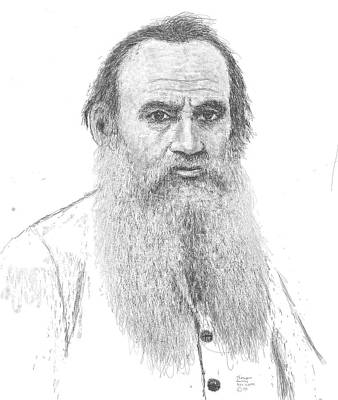Leo Tolstoy Archive
Written: 1904
Source: "Fables for Children," by Leo Tolstoy, translated from the original Russian and edited by leo Wiener, assistant Professor of Slavic Languages at Harvard University, published by Dana Estese Company, Boston, Edition De Luxe, limited to one thousand copies of which this is no. 411, copyright 1904, electrotyped and printed by C. H. Simonds and Co., Boston, Massachusetts, USA.
Transcription/Markup: Andy Carloff
Online Source: RevoltLib.com; 2021

If you pour salt into water and stir it, the salt will begin to melt and will entirely disappear; but if you pour more and still more salt into it, the salt will in the end not dissolve, and no matter how much you may stir after that, the salt will remain as a white powder. The water is saturated with the salt and cannot receive any more. But heat the water and it will receive more; and the salt which did not dissolve in the cold water, will melt in hot water. But pour in more salt, even the hot water will not receive it. And if you heat the water still more, the water will pass away in steam, and more of the salt will be left.
Thus, for everything which dissolves in the water there is a measure after which the water will not dissolve any more. Of anything, more will be dissolved in hot than in cold water, and in each case, when it is saturated, it will not receive any more. The thing will be left, but the water will go away in steam.
If the water is saturated with saltpeter powder, and then more saltpeter is added, and all is heated and is allowed to cool off without being stirred, the superfluous saltpeter will not settle as a powder at the bottom of the water, but will all gather in little six-edged columns, and will settle at the bottom and at the sides, one column near another. If the water is saturated with saltpeter powder and is put in a warm place, the water will go away in vapors, and the superfluous saltpeter will again gather in six-edged columns.
If water is saturated with simple salt and heated, and is allowed to pass away in vapor, the superfluous salt will not settle as powder, but as little cubes. If the water is saturated both with salt and saltpeter, the superfluous salt and saltpeter will not mix, but will settle each in its own way: the saltpeter in columns, and the salt in cubes.
If water is saturated with lime, or with some other salt, and anything else, each thing will settle in its own way, when the water passes away in vapor: one in three-edged columns, another in eight-edged columns, a third in bricks, a fourth in little stars,—each in its own way. These figures are different in each solid thing. At times these forms are as large as a hand,—such stones are found in the ground. At times these forms are so small that they cannot be made out with the naked eye; but in each thing there is its own form.
If, when the water is saturated with saltpeter, and little figures are forming in it, a corner be broken off one of these little figures with a needle, new pieces of saltpeter will come up and will fix the broken end as it ought to be,—into a six-edged column. The same will happen to salt and to any other thing. All the tiny particles turn around and attach themselves with the right side to each other.
When ice freezes, the same takes place.
A snowflake flies, and no figure is seen in it; but the moment it settles on anything dark and cold, on cloth, on fur,—you can make out its figure; you will see a little star, or a six-cornered little board. On the windows the steam does not freeze in any form whatever, but always as a star.
What is ice? It is cold, solid water. When liquid water becomes solid, it forms itself into figures and the heat leaves it. The same takes place with saltpeter: when it changes from a liquid into solid figures, the heat leaves it. The same is true of salt, of melted cast-iron, when it changes from a liquid into a solid. Whenever a thing changes from a liquid into a solid, heat leaves it, and it forms figures. And when it changes from a solid to a liquid it takes up heat, and the cold leaves it, and its figures are dissolved.
Bring in melted iron and let it cool off; bring in hot dough and let it cool off; bring in slacked lime and let it cool off,—and it will be warm. Bring in ice and let it melt,—and it will grow cold. Bring in saltpeter, salt, or any other thing that dissolves in the water, and melt it in the water, and it will grow cold. In order to freeze ice-cream, they put salt in the water.